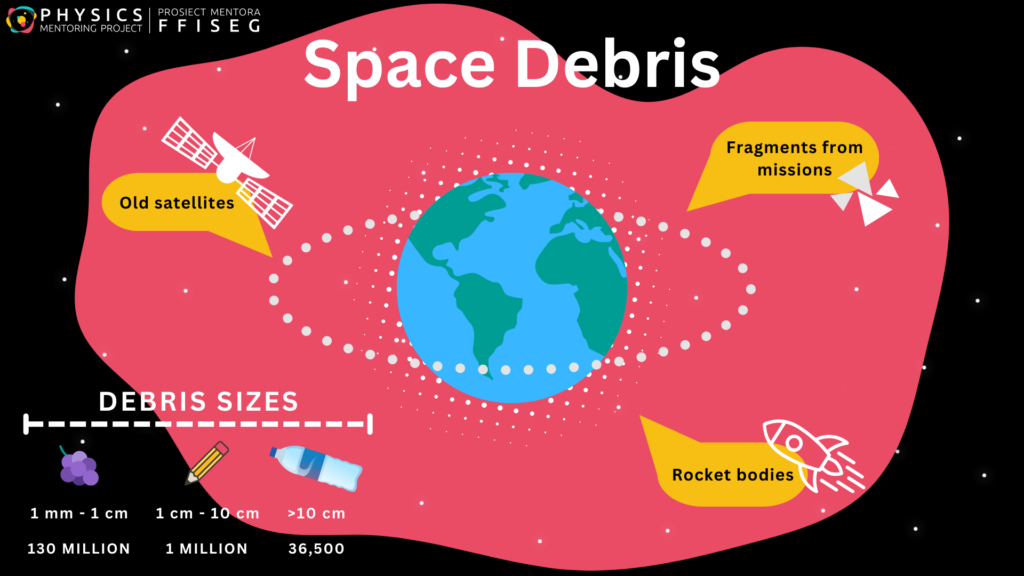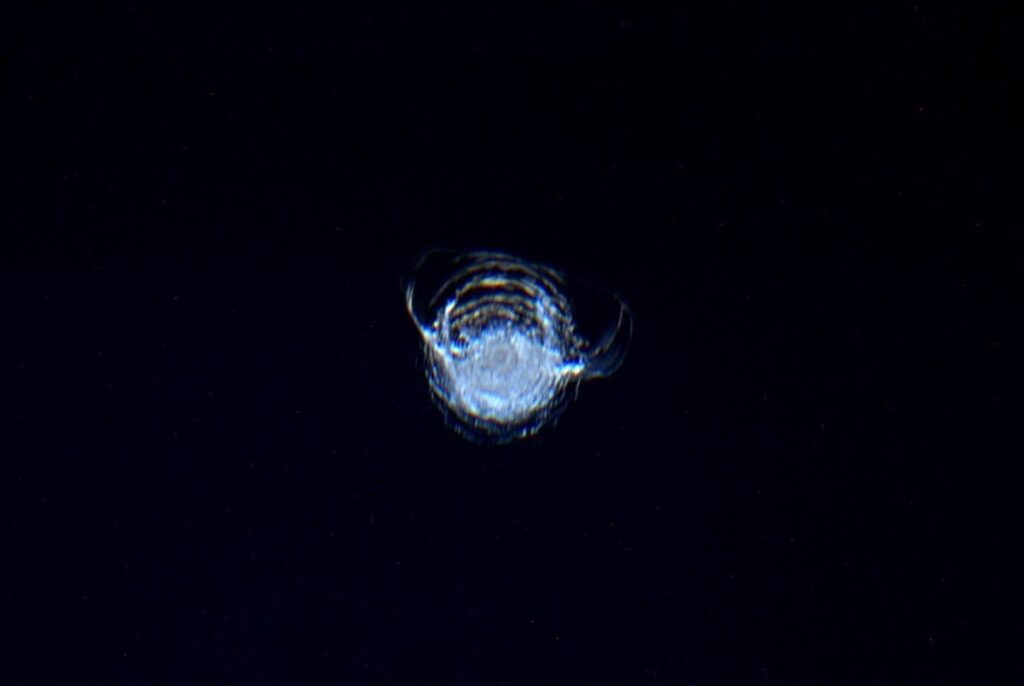What are space debris?
Space debris (also known as space junk) is the rubbish we’ve left in space, satellites that have failed, tools that astronauts dropped during spacewalks, and the remains of rocket stages when blasting a payload into orbit. This is space debris. Space debris also includes meteoroids however this post will discuss artificial debris from humankind (that’s us). Space debris has been discussed internationally, notably at the G7 regarding the Sustainable Use of Space and not long ago JWST had to travel through this debris field.
What size is it and how much is there?
Space debris comes in a range of sizes, and in the 60 or so years since the Space Age blasted off with the launch of the satellite Sputnik (1957), we’ve created a lot of it. According to the European Space Agency’s (ESA) statistical models, there are 130 million objects in space sizes 1mm to 1cm (a paperclip wire width to the size of a grape), 1,000,000 objects size 1 cm to 10 cm (your thumbnail to a new pencil), and 36,500 objects larger than 10 cm (the height of a water bottle).

Why are space debris a concern?
Space debris travels fast. Very fast. We have lots of satellites up in space used for telecommunication, GPS, and weather forecasting, things extremely important and used within our everyday lives. Now imagine you’re that satellite doing your important job and something the size of a paperclip, your thumbnail, a water bottle, comes zooming towards you faster than a bullet. You may be made of metal, but that’s still a nasty shock.
How likely are collisions?
Firstly, we need to establish, how busy is space? In space, there are currently around 10,550 satellites orbiting Earth (not all of these are functional, some are space debris, around 1/5). By the end of the decade, there are set to be 100,000 possibly 200,000 satellites and if even 1% of these fail, we now have 1,000 or 2,000 out-of-control satellites with masses of 100s of kgs, making traffic management a lot more difficult and collisions much more likely.

The ISS, which hosts astronauts conducting research, sometimes must manoeuvre to avoid space debris collisions or active satellites, 32 times since 1999. Recently in March 2023, it had to move higher in orbit to avoid the Argentinian satellite Nusat-17. This time NASA had plenty of warning to move as they knew the satellite was coming around in orbit. But what about very small space debris? So small it can’t be tracked. In 2016 Tim Peake took a photo of a window from part of the ISS called the Cupola. This image showed a 7mm chip in the window, caused by space debris that could be no larger than a few thousands of mm across. This may have been a small metal fragment or fleck of paint. This did not pose a risk to the ISS and its inhabitants as the windows are heavily glazed, however, anything up to a grape-sized object could immobilise a satellites flight system or other instruments, larger than this could breach the shields on the ISS, and anything larger than our water bottle-length debris colliding with a spacecraft could break it into fragments.
The ISS isn’t the only structure that has to move about in space; Starlink, a SpaceX satellite constellation, has made over 50,000 manoeuvres since launch to avoid collisions. It has been predicted that by 2028, Starlink may have to move nearly 100 million times in 6 months due to increases in space traffic. Remembering our possible 100,000 active satellites by 2030, the manoeuvring that will be required by satellites has been described as “like driving down the highway and swerving every 10 meters to avoid a collision” by Hugh Lewis, a professor at the University of Southampton. This doesn’t bode well for safety in space.
How do we get rid of it?

RemoveDEBRIS was the first mission to try and remove space debris, launched in 2018 (funded by ESA and completed by Surrey Space Centre). The payload was sent up into space and included three techniques to remove space debris which was deployed and tested in orbit.
- Net Capture – a CubeSat (a mini-satellite made up of cubes) is deployed from the payload in orbit. The CubeSat has an inflatable balloon that helps slow it to reach the same orbital speed as the space junk it is trying to capture. The CubeSat then deploys a net to capture the debris, and a tether line keeps it in place. The debris is dragged back down to earth as the CubeSat deorbits.
- Harpoon Capture – as it sounds, a harpoon, a barbed spear, is deployed. During the test that occurred an object of 10cm by 10cm, made of materials like a satellite, was deployed with it. The harpoon retrieved this object, demonstrating how this could be done with real space debris.
- The final technique is to prevent more space debris from being created when already trying to remove space debris. Finally, there was a drag sail which took the satellite out of orbit and pulled the spacecraft to Earth where it quickly burnt up in the atmosphere.
Other ideas for debris capture include using robotic arms to capture space junk and magnetic plates to attract magnetic debris. While many space sector organisations are thinking of ways to mitigate space debris at the end of their spacecraft’s life, not all companies will do this, if there are no national regulations in that country, they are not forced to follow guidelines. At present, there is nothing at international level to enforce necessary regulations.
Should we try and remove all space debris that we can?
There are arguments against this. Space junk isn’t just junk, it is the archaeological history of space, comparable to the UNESCO sites on Earth like the Castles and the Town Walls of King Edward I in Gwynedd, Wales.
Furthermore, supported by the 1997 Outer Space Treaty space is a global common (students of geography might recognise this word), it’s like Antarctica, no one owns it, and everyone is allowed reasonable access. However as more private companies go to space, they may want to claim certain orbits and areas for their satellite constellations. By keeping a satellite like NigComSat1, Nigeria’s first telecommunications satellite launched in 2007 then failed a year later, it demonstrates Nigeria’s historical use of space to anyone that may challenge it. To protect heritage conservation, there is an idea to leave a sample from every space-faring nation up in orbit, to demonstrate their right to space.
However, without clearing space debris, some areas of space may become unusable and critical infrastructure could be damaged daily as we become less able to move satellites and spacecraft out of the path of collisions.
Conclusion
In conclusion, space debris and the sustainable use of space is a pressing issue at this time and will be even more critical by the end of this decade. At the G7 space debris has been internationally recognised as a core issue and we see organisations working on solutions to reduce space debris, as well as spacecraft and satellite organisations thinking more on how to sustainably remove what they put into space, at the end of its life. Space is free and accessible to everyone; therefore, it is everyone’s responsibility to conserve it.
Sources
General Space Debris:
- “Episode 18: A Hunk of Space Junk” – The Supermassive Podcast, The Royal Astronomical Society
- Space Debris and Human Spacecraft – NASA
- Space debris by the numbers – ESA
- “ISS Averts Clash With Argentine EO Satellite” – Geospatial World
- “G7 nations commit to the safe and sustainable use of space” – UK Government
Collisions/Possible Collisions:
- “International Space Station fires thrusters to avoid collision with satellite” – Space.com
- Impact chip – ESA
- “SpaceX Starlink satellites had to make 25,000 collision-avoidance maneuvers in just 6 months — and it will only get worse” – Space.com
Removing Space Debris:
- “Cleaning up space junk” – The Royal Society
- Mission Overview – University Of Surrey
- “Harpoon successfully captures space debris” – University Of Surrey
- “Net successfully snares space debris” – University Of Surrey
- “RemoveDEBRIS mission tests methods to remove the danger of space waste” – Space South Central
Space Heritage:
- Trash or treasure? A lot of space debris is junk, but some is precious heritage-The Conversation
- NIGCOMSAT1, 1R- Gunther’s Space Page





